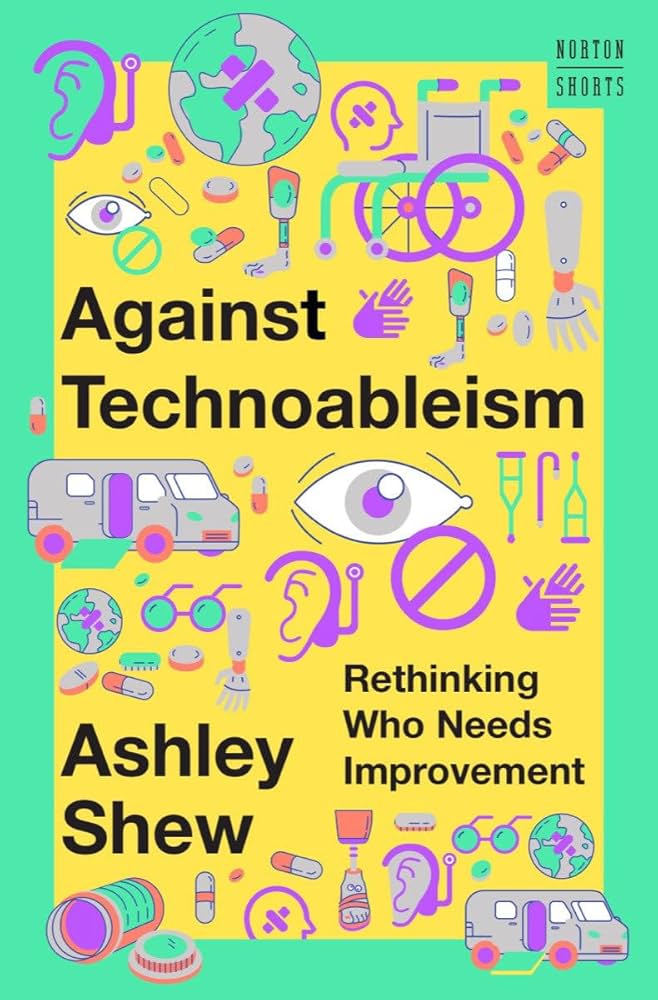Against Technoableism

High-Level Overview: Key Arguments and Goals
Critique of Technoableism: Technology is wrongly positioned as the primary "solution" for disability, perpetuating the harmful belief that disabled people are simply waiting to be "fixed" by technological innovation.
Rejection of "Fixing" Disabled People: The dominant conviction that disabled people are "broken" and require fixing is fundamentally flawed; disabled people's primary problem is not technical but social.
Centering Disabled Expertise: Disabled people are the true experts on disability and assistive technology, yet are systematically excluded from conversations about technologies designed for their benefit.
Challenging Harmful Narratives: Five pervasive disability tropes (pitiful freaks, shameful sinners, moochers and fakers, bitter cripples/villains, and inspirational overcomers) distort public understanding and harm disabled communities.
The Future is Disabled: Everyone will likely experience disability through aging, climate change, or other factors, making accessible design essential for all humanity.
Disability Justice Framework: Moving beyond mere accommodation toward comprehensive justice that centers the most marginalized and connects to broader liberation struggles.
Call for Cross-Disability Solidarity: Building coalitions across different disability experiences and with other justice movements to create truly accessible futures.
Overall Summary
Ashley Shew's Against Technoableism: Rethinking Who Needs Improvement is a manifesto that challenges prevailing assumptions about disability, technology, and who actually requires "improvement." The book argues that contemporary society is saturated with technoableism, the harmful ideology that positions technology as the primary solution to disability and frames disabled people as incomplete individuals awaiting technological "fixes." This perspective obscures the real problem: a world designed to exclude disabled people rather than accommodate them.
Drawing on her own experience of becoming disabled at age 30 (describing herself as "a hard-of-hearing chemobrained amputee with Crohn's disease and tinnitus"), Shew illuminates how most nondisabled people fundamentally misunderstand what disabled people want and need. The book exposes how well-meaning technological interventions often reinforce ableist assumptions, rob disabled people of agency, and distract from the crucial work of building accessible social structures. Rather than celebrating every new prosthetic or assistive device as miraculous progress, Shew insists we must ask who benefits from these narratives and whether technology actually serves disabled communities or primarily serves nondisabled people's comfort.
The book operates simultaneously as memoir, academic intervention, and activist manifesto. It celebrates disability scholars and activists including Alice Wong, Leah Lakshmi Piepzna-Samarasinha, and the late Bill Peace, while providing both a theoretical framework for understanding technoableism and practical guidance for dismantling it. Central to Shew's argument is the recognition that disability is not exceptional but universal: virtually everyone will experience disability at some point in their lives. This reality demands that we reconceptualize disability not as a deficit requiring correction but as a form of embodied expertise essential for navigating an uncertain future. The book calls for a complete reorientation from asking "how do we fix disabled people?" to asking "how do we fix the ableist world that disables people?"
Part I: Understanding Technoableism
Defining Technoableism and Disability Tropes
The book opens by satirizing expected disability memoir conventions: the "horrible birth" or "grave-brave injury" narratives that frame disabled lives as tragedies requiring heroic overcoming. Shew immediately rejects this narrative structure, establishing that disabled lives need not be defined by trauma or the relentless pursuit of normalcy.
Shew explains that "ableism is the sauce we're all marinated in," a pervasive ideology so normalized that even disabled people internalize it. Technoableism represents a specific manifestation: the channeling of ableist assumptions through technological development. Under technoableism, technologies are positioned as cure-alls for disability, with each new device celebrated as bringing disabled people closer to "normal" functioning. This framework assumes the problem lies within disabled bodies rather than within inaccessible social structures.
The book identifies five dominant disability tropes that saturate media representations: pitiful freaks (disabled people as objects of medical curiosity or pity), shameful sinners (disability framed as divine punishment), moochers and fakers (disabled people depicted as fraudulently accessing services), bitter cripples/villains (villains marked by disability signifiers), and inspirational overcomers (disabled people celebrated merely for existing or performing everyday tasks). These tropes collectively deny disabled people full humanity and agency.
Medical vs. Social Model of Disability
A fundamental distinction is the contrast between the medical model and the social model of disability. The medical model locates disability within individual bodies as a problem requiring medical or technological intervention to "fix." The social model locates disability in the interaction between bodies and inaccessible environments. Under this framework, someone who uses a wheelchair is not disabled by their body but by stairs without ramps and buildings without elevators. Technoableism is deeply rooted in the medical model, consistently positioning technology as the solution to "broken" bodies rather than advocating for accessible design or systemic change.
Disability as Expertise
A cornerstone of Shew's argument is that disabled people possess unique expertise about disability, technology, and accessibility, yet are systematically excluded from decisions about technologies supposedly designed for their benefit. Engineers and technology companies routinely develop assistive devices without meaningful input from disabled communities, resulting in products that fail to meet actual needs. This exclusion reveals that technoableism is less about helping disabled people and more about making nondisabled people comfortable with disability's existence.
Part II: Critiquing Technological Narratives
Prosthetics and the Cyborg Mythology
Shew examines prosthetics, perhaps the most celebrated category of assistive technology. The dominant narrative presents prosthetics as universally desired by amputees, with more "advanced" prosthetics positioned as inherently superior. The reality is far more complex. Many amputees choose not to use prosthetics at all, finding them uncomfortable or impractical. Others prefer simpler mechanical prosthetics over high-tech computerized alternatives that are heavier, more expensive, and prone to malfunction. The celebrated technologies are often designed more to impress nondisabled observers than to serve disabled users' practical needs.
The cyborg mythology, the idea that merging human bodies with technology creates "enhanced" capabilities, is particularly harmful. This narrative frames disability as an opportunity for technological transcendence while ignoring disabled people's actual lives and preferences. It is fundamentally extractive, mining disabled experiences to fuel nondisabled fantasies about human enhancement.
Inspiration Porn and Supercrip Narratives
Building on disability activist Stella Young's concept of "inspiration porn," Shew critiques how disabled people are routinely positioned as inspirational merely for existing. The "supercrip" narrative depicts disabled individuals who overcome extraordinary odds, often aided by technology. While seemingly positive, this narrative places impossible expectations on disabled people to constantly prove their worth through exceptional achievement. Technology becomes the hero of these stories, with the disabled person serving as proof of its value.
Neurodivergence and Historical Context
The book addresses how technoableism operates in relation to neurodivergence and cognitive disabilities. Technologies are increasingly deployed to surveil or modify neurodivergent behavior, typically aiming to make neurodivergent people appear more "normal" rather than addressing how social structures exclude neurodivergent ways of being. The book also examines troubling historical legacies, including figures like Hans Asperger and the Nazi origins of certain autism categorizations, illuminating how definitions of cognitive disability have been weaponized.
Accessibility vs. Assistive Technology
A crucial distinction is between accessibility (designing environments to be usable by all) and assistive technology (devices individual disabled people use to navigate inaccessible environments). Technoableism conflates these, suggesting assistive technology is an adequate substitute for accessibility. This framing privatizes disability, making it disabled individuals' responsibility to acquire expensive technologies rather than society's responsibility to design inclusively.
Part III: Disability Justice and Intersectionality
The Eugenic Legacy
Shew situates contemporary technoableism within a longer history of projects aimed at "improving" or eliminating disabled people, including eugenics movements, forced sterilization, and institutionalization. The language of "improvement" carries this eugenic legacy. The book examines how technologies like prenatal testing and genetic engineering continue eugenic logic, operating within a cultural context that devalues disabled lives and frames disability as tragedy.
Ableism, Racism, and Intersectionality
The book emphasizes the crucial relationship between disability and race, examining how ableism and racism are intertwined systems of oppression. Shew argues for intersectional analysis that recognizes how race, class, gender, and other identities shape disabled experience. Technologies celebrated as solutions often serve primarily white, wealthy disabled people while remaining inaccessible to multiply marginalized disabled communities.
Disability Justice Framework
Shew advocates for a disability justice framework that goes beyond mere accommodation. Disability justice, developed by disabled activists of color, centers the most marginalized disabled people, recognizes disability as political identity, and connects disability liberation to broader struggles against oppression. Under disability justice, the goal is not to help disabled people approximate nondisabled norms but to transform norms themselves.
Part IV: Envisioning Accessible Futures
Counterventions
Rather than celebrated technologies designed by nondisabled engineers, Shew highlights "counterventions," innovations developed by and for disabled communities. These include low-tech solutions, community organizing, and mutual aid networks. Counterventions often look nothing like high-tech devices: community-created accessibility maps, informal networks sharing information, creative adaptations of everyday objects. These solutions emerge from disabled expertise and prioritize practicality and community autonomy.
The Future is Disabled
One of the book's most provocative arguments is that the future is inevitably disabled. Space exploration will disable human bodies in predictable ways through bone density loss and muscle atrophy. Climate change will create more disability through injury, illness, and chronic conditions. Aging means most people will experience disability. These realities make disability expertise invaluable. Disabled people have developed knowledge about navigating hostile environments, adapting to bodily changes, and building interdependent communities, precisely what humanity will need as we confront challenging futures.
Shew argues for universal design as essential rather than optional. Universal design benefits everyone: curb cuts help wheelchair users but also people with strollers, closed captions help deaf people but also people in loud environments, flexible work arrangements help chronically ill people but also parents and students.
Building Cross-Disability Solidarity
The book emphasizes solidarity across different disabilities: physical, sensory, cognitive, psychiatric, and chronic illness. Different disabilities are often pitted against each other in competition for limited resources. Cross-disability solidarity requires recognizing both commonalities and differences, learning from each other's experiences, and refusing hierarchies that value some disabled lives over others. This solidarity must extend to other justice movements, as disability justice is inseparable from racial justice, economic justice, and environmental justice.
Conclusion: Who Needs Improvement?
Ashley Shew's Against Technoableism concludes by returning to its central provocation: the question of who truly needs improvement. The answer is unequivocal: not disabled people, but the ableist systems, structures, and assumptions that disable them. The book insists that technology is not a neutral force for progress but a site of political struggle where ableist ideologies are reproduced and sometimes challenged.
The path forward requires centering disabled expertise, embracing disability justice, building cross-movement solidarity, and fundamentally questioning the assumption that disabled people need or want to be made "normal." It demands recognizing disability not as deficit but as embodied difference and source of knowledge; not as individual tragedy but as political identity and site of community; not as problem requiring solution but as part of human diversity deserving of full inclusion.
Shew offers a vision of accessible futures built on disabled people's wisdom, characterized by interdependence rather than coerced independence, and oriented toward collective liberation rather than individual accommodation. This vision requires dismantling ableism in all its forms, including the seductive technoableist promises that position technology as disability's cure rather than addressing the social, political, and environmental factors that actually disable people. The book serves simultaneously as wake-up call, permission slip, and roadmap: waking nondisabled people to their complicity in ableism, giving disabled people permission to reject harmful narratives, and charting paths toward genuinely accessible futures.
